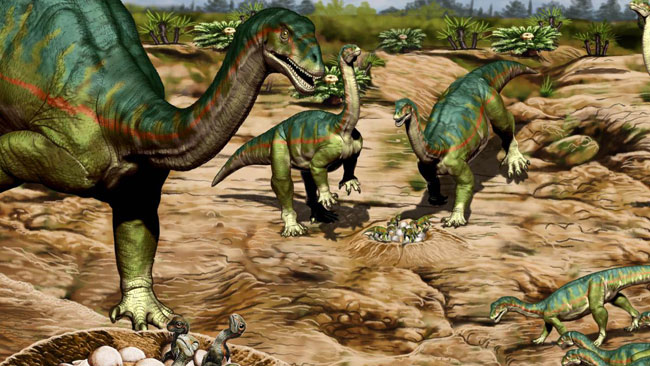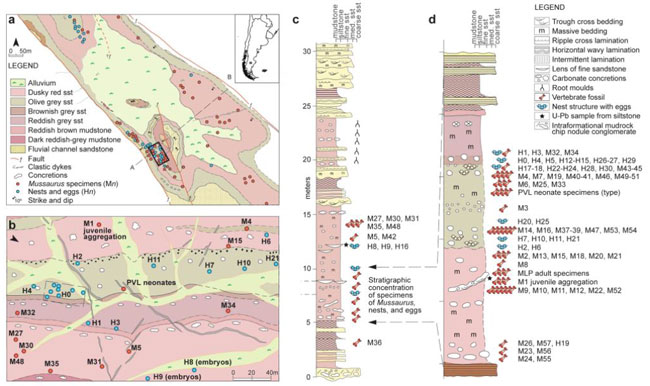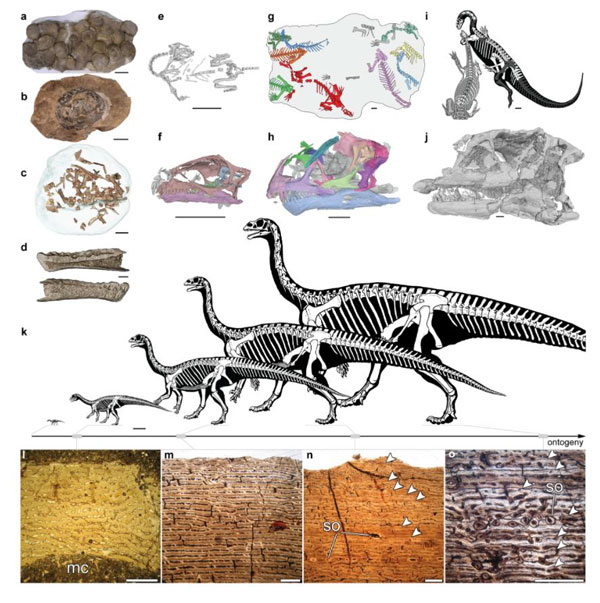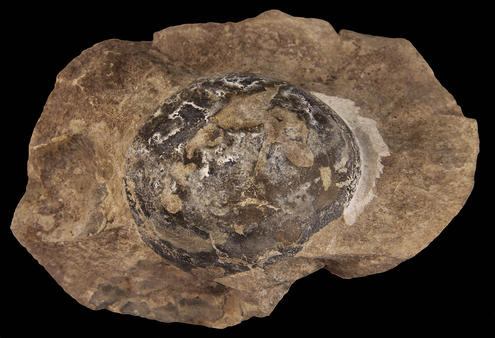Researchers studying an extensive dinosaur nesting site associated with the Early Jurassic sauropodomorph Mussaurus patagonicus have suggested that these dinosaurs migrated to preferred colonial nesting areas and indulged in complex social behaviours. Articulated skeletons grouped in clusters of individuals of approximately the same age indicate the presence of social cohesion throughout life and age-segregation within a herd structure. This is the earliest evidence found to date of complex behaviours within the Dinosauria and the researchers postulate that their social behaviour may have been a key factor in their rise to dominance.

Dinosaurs Living in Herds
Substantial evidence has been uncovered to demonstrate that different types of herbivorous dinosaurs lived in herds. There are extensive trackways and substantial hadrosaur and ceratopsian bonebeds dating from the Late Cretaceous, there has also been some evidence, albeit controversial, to suggest that some meat-eating dinosaurs lived in packs or family groups, but when did this sort of behaviour evolve in the Dinosauria? A team of international researchers studying a 192-million-year-old nesting ground located in southern Argentina (Santa Cruz Province), have demonstrated that complex social behaviours existed in sauropodomorphs.
The site, which covers an area of approximately 1,000 square metres, the locality representing river and lake deposits part of the Laguna Colorada Formation, has yielded over 100 fossil eggs in various degrees of association, from individual finds to entire clutches and over 80 specimens of Mussaurus patagonicus, at very stages of growth from embryos to fully grown adults.

The European Synchrotron Radiation Facility (ESRF)
Thirty fossil eggs were selected to take the trip to the European Synchrotron Radiation Facility (ESRF) in Grenoble, France for further, detailed study. Once at the facility, the eggs were bombarded with powerful, high-intensity X-rays so that their contents could be revealed. This non-destructive technique permitted the research team, which was led by Diego Pol, a palaeontologist at CONICET (Consejo Nacional de Investigaciones Científicas y Técnicas), the Government agency that fosters science and technology in Argentina, to confirm that the eggs were those of Mussaurus patagonicus. The high-resolution computed tomography revealed fossilised embryos of Mussaurus within some of the eggs and showed all these fossils belong to a communal breeding site of a single dinosaur species.

An Organised and Regimented Herd Structure
Field work revealed that the Mussaurus skeletons were not randomly scattered across the site. They were clustered together according to their age. Babies were found in close proximity to the nests as would have been expected. However, the remains of one-year-olds were found closely associated with each other, including a group of eleven skeletons all preserved in the same resting pose. This suggests that Mussaurus youngsters stayed together, probably for protection against predators.
Intriguingly, the fossilised remains of adults and sub-adults were frequently found alone or in pairs. Perhaps the pair represented a male and female, which had got together for the breeding season.
The team which included Vincent Fernandez, a palaeontologist at the London Natural History Museum and former ESRF scientist, undertook histological analysis of thin sections of fossil bone so that they could observe the lines of arrested growth (LAGs) and calculate the age of the dinosaur.
Lead author Diego Pol explained:
“The bones of these dinosaurs grew in annual cycles, much as the tree rings, so by counting the growth cycles we could infer the age of the dinosaur”.
Social Behaviour – Key to the Success of the Dinosauria?
The location had proved difficult to date. Previous studies had suggested the site was much older, the deposits thought to have been laid down in the Late Triassic, but the team were able to accurately date the fossil site by plotting the decay of uranium to lead in zircon crystals found in siltstones in a fossil bearing layer (U–Pb zircon geochronology). The results prove that the Mussaurus nesting colonies were formed around 192 million years ago (Sinemurian faunal stage of the Early Jurassic). As fossil bones were found at several distinct layers, this suggests that these dinosaurs returned to this favoured nesting site year after year.
The researchers conclude that Mussaurus lived in well-organised herds and this is the first time these complex behaviours have been recorded in an early dinosaur. It pre-dates other records of dinosaur social behaviour by more than 40 million years. Furthermore, by studying colonial nesting in the similarly aged early sauropodomorphs Lufengosaurus from China and Massospondylus from South Africa, the team suggest that complex nesting behaviours and organised herd structures emerged very early in dinosaur evolution.

Living in herds, exhibiting complex social behaviours and breeding in colonies at preferred nesting locations may have contributed to the success of these early dinosaurs, which enabled sauropodomorphs to become a mainstay of terrestrial ecosystems, laying the foundation for the success of the Sauropoda for most of the Mesozoic.
To read a related article on Mussaurus patagonicus from 2019, that looks at how the Laguna Colorada fossil site has helped palaeontologists to understand dinosaur locomotion: Some Baby Dinosaurs Crawled Before Learning to Walk on Two Legs.
The scientific paper: “Earliest evidence of herd-living and age segregation amongst dinosaurs” by Diego Pol, Adriana C. Mancuso, Roger M. H. Smith, Claudia A. Marsicano, Jahandar Ramezani, Ignacio A. Cerda, Alejandro Otero and Vincent Fernandez published in Scientific Reports.






Leave A Comment